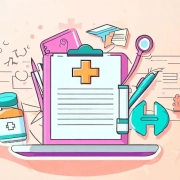PICO Question Examples Heart Disease Guide for Students
 Heart disease stands tall as one of the world’s leading causes of mortality, making it a vital subject of study for healthcare professionals across the globe. As you embark on your quest to become compassionate and knowledgeable caregivers, understanding how to frame clinical questions using the PICO format will prove indispensable for your evidence-based practice. From seasoned healthcare professionals to novice nursing students, everyone can find value in harnessing the potential of PICO to explore the depths of cardiac ailments, treatments, and preventive measures.
Heart disease stands tall as one of the world’s leading causes of mortality, making it a vital subject of study for healthcare professionals across the globe. As you embark on your quest to become compassionate and knowledgeable caregivers, understanding how to frame clinical questions using the PICO format will prove indispensable for your evidence-based practice. From seasoned healthcare professionals to novice nursing students, everyone can find value in harnessing the potential of PICO to explore the depths of cardiac ailments, treatments, and preventive measures.
Picture yourself on the threshold of a world where every question holds the potential to uncover valuable insights, shape patient care, and save lives. The PICO format – Patient/Population, Intervention, Comparison, and Outcome – serves as a guiding compass, allowing you to navigate the vast sea of medical information and steer your focus toward relevant and answerable queries.
We understand that the path to becoming a skilled and empathetic healthcare provider is filled with challenges, uncertainties, and moments of awe. And it is precisely with this understanding that we’ve crafted PICO questions that ignite your curiosity, inspire your dedication, and empower you to find answers that shape the future of heart disease management.
Whether you’re a nursing student just starting your journey or a seasoned practitioner seeking to refine your approach, this comprehensive guide will be your ultimate guide for formulating PICO questions, tailored specifically to address heart diseases. Together, we will discover the art of crafting precise and impactful questions, harnessing the power of evidence-based practice to enhance patient outcomes and contribute to the noble cause of healthcare.
Understanding Heart Disease and Its Impact
Before we explore PICO questions, it’s crucial to grasp the impact of heart disease on individuals and societies worldwide. Heart disease, also called cardiovascular disease, covers various heart and blood vessel conditions, like coronary artery disease and heart failure.
Heart disease is the leading global cause of death, affecting people of all ages and backgrounds. As nursing students, you’ll witness its toll during clinical experiences – physically, emotionally, and socially on patients and families.
But there’s hope – cardiology has made strides in understanding and treating heart disease. As nurses, you’ll play a vital role in this fight, making a difference in patients’ lives.
PICO questions are the foundation of evidence-based practice, helping you focus your research for more relevant patient care. Remember, your patients are more than data; they have unique stories. Approach your quest with empathy and compassion.
The goal is to improve the lives of those affected by heart disease and create a healthier society. Armed with evidence-based practice and compassion, let’s journey forth to unlock the potential of PICO questions in managing heart disease.
Understanding the PICO Framework: A Guide for Nursing Students
Alright, folks, let’s roll up our sleeves and dive headfirst into the heart of the matter – the PICO framework! Now, I know it may sound a bit technical, but trust me; it’s nothing we can’t handle together. Think of it as your trusty roadmap, guiding you through the maze of information and helping you find those precious gems of knowledge.
- Patient/Population (P) – The Starting Point: First things first, we need to know whom we’re talking about. Who’s at the center of our question? It’s the patients, of course! Whether they’re young or old, male or female, with specific risk factors or not – defining your patient population is crucial. For example, you might be curious about how heart disease affects elderly individuals with diabetes. So, our (P) in this case would be: “Elderly patients with diabetes.”
- Intervention (I) – What Are We Doing? Now that we’ve got our patients in mind, it’s time to think about what we’re going to do for them. The intervention is all about the action – the treatment, therapy, or approach you want to explore. For instance, let’s say we’re curious about the effectiveness of a new medication. Our (I) would be: “Administration of the new heart disease medication.”
- Comparison (C) – Weighing the Options: Here’s where things get interesting. To really know if our intervention is making a difference, we need something to compare it to – like a benchmark or an alternative treatment. It’s the yin to our intervention’s yang! So, sticking with our example, our (C) could be: “Compared to standard heart disease medications.”
- Outcome (O) – What’s the Result? Last but not least, let’s talk about what we’re hoping to achieve here. The outcome is the endgame – what we’re measuring to see if our intervention did the trick. Are we aiming to reduce symptoms, improve quality of life, or lower the risk of certain complications? You decide! So, in our case, our (O) might be: “Reduction in the frequency of heart disease-related hospitalizations.”
Now that we’ve got all our PICO components sorted, it’s time to put them together and create a rock-solid question that guides our research. So, let’s weave our magic:
“In elderly patients with diabetes, does the administration of the new heart disease medication result in a significant reduction in the frequency of heart disease-related hospitalizations compared to standard heart disease medications?”
Ta-da! We’ve crafted our very own PICO question, custom-tailored to address a specific aspect of heart disease. And guess what? This is just the beginning! Armed with this newfound PICO prowess, you can explore various angles of heart disease, investigate diverse interventions, and uncover a treasure trove of evidence to inform your nursing practice.
Real-Life Scenarios PICO Question Examples for Heart Disease Research
We’re going to explore some real-life scenarios where PICO questions can lead us to valuable insights about heart disease. These scenarios aren’t just hypotheticals; they represent actual challenges that healthcare professionals face daily.
Scenario 1: Preventive Strategies for Hypertensive Young Adults
P: Young adults (age 18-30) with hypertension
I: Engaging in regular physical activity and adopting a heart-healthy diet
C: Not engaging in regular physical activity and following an unhealthy diet
O: Reduction in blood pressure levels and cardiovascular risk factors
PICO Question: “In young adults with hypertension, does engaging in regular physical activity and adopting a heart-healthy diet lead to a significant reduction in blood pressure levels and cardiovascular risk factors compared to those who do not follow such lifestyle interventions?”
Scenario 2: Medication Adherence in Elderly Heart Failure Patients
P: Elderly patients (age 65 and above) with heart failure
I: Implementing a structured medication adherence program
C: No structured medication adherence program in place
O: Improvement in medication adherence and reduction in heart failure exacerbations
PICO Question: “Among elderly heart failure patients, does implementing a structured medication adherence program lead to improved medication adherence and a reduction in heart failure exacerbations compared to those without such a program?”
Scenario 3: Statin Therapy for Diabetic Patients with Coronary Artery Disease
P: Diabetic patients with diagnosed coronary artery disease
I: Prescribing statin therapy to manage cholesterol levels
C: Not prescribing statin therapy to manage cholesterol levels
O: Reduction in LDL cholesterol levels and incidence of cardiovascular events
PICO Question: “In diabetic patients with coronary artery disease, does prescribing statin therapy result in a significant reduction in LDL cholesterol levels and a lower incidence of cardiovascular events compared to not prescribing statins?”
Scenario 4: Telemonitoring for Post-Cardiac Surgery Patients
P: Patients recovering from cardiac surgery
I: Implementing a telemonitoring system for remote patient monitoring
C: Traditional in-person follow-up care post-surgery
O: Early detection of post-surgery complications and reduced hospital readmission rates
PICO Question: “Among patients recovering from cardiac surgery, does the implementation of a telemonitoring system lead to early detection of post-surgery complications and a reduction in hospital readmission rates compared to traditional in-person follow-up care?”
Scenario 5: Smoking Cessation Intervention for Patients with Angina
P: Patients diagnosed with angina (chest pain due to reduced blood flow to the heart)
I: Providing a smoking cessation program and counseling
C: No specific smoking cessation intervention provided
O: Reduction in angina symptoms and improvement in overall heart health
PICO Question: “In patients with angina, does providing a smoking cessation program and counseling lead to a reduction in angina symptoms and improved overall heart health compared to those who do not receive such intervention?”
Scenario 6: Exercise Rehabilitation for Heart Attack Survivors
P: Individuals who have recently survived a heart attack
I: Participating in a structured exercise rehabilitation program
C: No exercise rehabilitation program provided after the heart attack
O: Improved cardiovascular fitness and reduced risk of secondary cardiac events
PICO Question: “In individuals who have recently survived a heart attack, does participating in a structured exercise rehabilitation program lead to improved cardiovascular fitness and a reduced risk of secondary cardiac events compared to those who do not receive such rehabilitation?”
Scenario 7: High Blood Pressure Screening in Workplaces
P: Employees in various workplaces
I: Implementing regular blood pressure screening programs at workplaces
C: No regular blood pressure screening at workplaces
O: Early detection of high blood pressure cases and improved awareness of cardiovascular health
PICO Question: “In workplaces, does implementing regular blood pressure screening programs lead to early detection of high blood pressure cases and improved awareness of cardiovascular health compared to workplaces without such screening?”
Scenario 8: Mindfulness Meditation for Stress Reduction in Heart Disease Patients
P: Patients diagnosed with heart disease
I: Incorporating mindfulness meditation into their daily routine
C: No specific stress reduction techniques provided
O: Lower stress levels, improved emotional well-being, and better heart health
PICO Question: “Among patients diagnosed with heart disease, does incorporating mindfulness meditation into their daily routine lead to lower stress levels, improved emotional well-being, and better heart health compared to those who do not practice specific stress reduction techniques?”
Scenario 9: Beta-Blocker Therapy for Congestive Heart Failure
P: Patients diagnosed with congestive heart failure
I: Administering beta-blocker medications as part of the treatment
C: No beta-blocker therapy prescribed for congestive heart failure management
O: Improved heart function, reduced hospitalizations, and increased survival rates
PICO Question: “In patients diagnosed with congestive heart failure, does administering beta-blocker medications as part of the treatment result in improved heart function, reduced hospitalizations, and increased survival rates compared to those without beta-blocker therapy?”
Scenario 10: Cardiovascular Risk Assessment in Obese Individuals
P: Obese individuals (BMI ≥ 30)
I: Conducting comprehensive cardiovascular risk assessments
C: No specific cardiovascular risk assessment for obese individuals
O: Early identification and management of cardiovascular risk factors
PICO Question: “Among obese individuals, does conducting comprehensive cardiovascular risk assessments lead to early identification and management of cardiovascular risk factors compared to those without such assessments?”
Scenario 11: Dietary Sodium Restriction for Hypertensive Patients
P: Patients diagnosed with hypertension
I: Following a low-sodium diet
C: Consuming a regular diet without specific sodium restrictions
O: Reduction in blood pressure levels and decreased risk of heart-related complications
PICO Question: “In patients diagnosed with hypertension, does following a low-sodium diet lead to a reduction in blood pressure levels and a decreased risk of heart-related complications compared to consuming a regular diet without specific sodium restrictions?”
Scenario 12: Exercise-Based Cardiac Rehabilitation for Heart Bypass Surgery Patients
P: Patients who underwent heart bypass surgery
I: Participating in exercise-based cardiac rehabilitation programs
C: No exercise-based cardiac rehabilitation provided post-surgery
O: Enhanced physical fitness, improved recovery, and reduced post-surgery complications
PICO Question: “Among patients who underwent heart bypass surgery, does participating in exercise-based cardiac rehabilitation programs lead to enhanced physical fitness, improved recovery, and reduced post-surgery complications compared to those who do not receive such rehabilitation?”
Scenario 13: Use of Aspirin for Secondary Prevention in Coronary Artery Disease Patients
P: Patients diagnosed with coronary artery disease
I: Prescribing aspirin for secondary prevention
C: Not prescribing aspirin for secondary prevention
O: Decreased risk of cardiovascular events and improved long-term outcomes
PICO Question: “In patients diagnosed with coronary artery disease, does prescribing aspirin for secondary prevention lead to a decreased risk of cardiovascular events and improved long-term outcomes compared to not prescribing aspirin?”
Scenario 14: Sleep Quality and Heart Health in Young Adults
P: Young adults (age 18-30)
I: Improving sleep quality and duration
C: Maintaining usual sleep patterns
O: Reduced risk of developing cardiovascular diseases in the future
PICO Question: “Among young adults, does improving sleep quality and duration lead to a reduced risk of developing cardiovascular diseases in the future compared to maintaining usual sleep patterns?”
Scenario 15: Omega-3 Fatty Acid Supplementation for High Triglyceride Levels
P: Patients with elevated triglyceride levels
I: Taking omega-3 fatty acid supplements
C: Not taking omega-3 fatty acid supplements
O: Reduction in triglyceride levels and improved lipid profile
PICO Question: “In patients with elevated triglyceride levels, does taking omega-3 fatty acid supplements lead to a reduction in triglyceride levels and an improvement in lipid profile compared to those not taking omega-3 supplements?”
Scenario 16: Cardiac Screening in Professional Athletes
P: Professional athletes in various sports
I: Regular cardiac screening and evaluations
C: No regular cardiac screening for professional athletes
O: Early detection of heart abnormalities and prevention of sudden cardiac events
PICO Question: “Among professional athletes, does regular cardiac screening and evaluations lead to early detection of heart abnormalities and a reduction in the occurrence of sudden cardiac events compared to those without regular screening?”
Scenario 17: Yoga for Blood Pressure Management in Prehypertensive Individuals
P: Individuals with prehypertension (elevated blood pressure, but not yet hypertension)
I: Engaging in regular yoga practice
C: Not engaging in regular yoga practice
O: Lower blood pressure levels and reduced progression to hypertension
PICO Question: “In individuals with prehypertension, does engaging in regular yoga practice lead to lower blood pressure levels and a reduced progression to hypertension compared to those who do not practice yoga?”
Scenario 18: Remote Cardiac Rehabilitation for Rural Heart Disease Patients
P: Heart disease patients living in rural areas
I: Utilizing remote cardiac rehabilitation programs
C: No access to remote cardiac rehabilitation services
O: Improved accessibility to rehabilitation services and better heart health outcomes
PICO Question: “Among heart disease patients living in rural areas, does utilizing remote cardiac rehabilitation programs lead to improved accessibility to rehabilitation services and better heart health outcomes compared to those without access to such services?”
Scenario 19: Angioplasty vs. Bypass Surgery for Coronary Artery Disease
P: Patients diagnosed with severe coronary artery disease
I: Undergoing angioplasty (percutaneous coronary intervention)
C: Undergoing bypass surgery (coronary artery bypass grafting)
O: Comparison of mortality rates and long-term outcomes between the two procedures
PICO Question: “In patients diagnosed with severe coronary artery disease, what are the differences in mortality rates and long-term outcomes between those who undergo angioplasty (PCI) and those who undergo bypass surgery (CABG)?”
Scenario 20: Impact of Smoking Cessation on Heart Health
P: Smokers without a history of heart disease
I: Quitting smoking and seeking smoking cessation support
C: Continuing to smoke without seeking cessation support
O: Reduction in the risk of developing heart disease and improvement in lung function
PICO Question: “Among smokers without a history of heart disease, does quitting smoking and seeking smoking cessation support lead to a reduction in the risk of developing heart disease and an improvement in lung function compared to those who continue to smoke without seeking support?”
Scenario 21: Effect of Omega-3 Fatty Acids on Arrhythmias
P: Patients with a history of arrhythmias
I: Consuming omega-3 fatty acid supplements
C: Not consuming omega-3 fatty acid supplements
O: Reduction in the frequency and severity of arrhythmic episodes
PICO Question: “In patients with a history of arrhythmias, does consuming omega-3 fatty acid supplements lead to a significant reduction in the frequency and severity of arrhythmic episodes compared to those who do not consume such supplements?”
Scenario 22: Impact of Stress Reduction Techniques on Hypertension
P: Individuals diagnosed with hypertension
I: Engaging in stress reduction techniques (e.g., meditation, mindfulness)
C: Not practicing stress reduction techniques
O: Reduction in blood pressure levels and overall improvement in mental well-being
PICO Question: “Among individuals diagnosed with hypertension, does engaging in stress reduction techniques, such as meditation and mindfulness, lead to a reduction in blood pressure levels and an improvement in mental well-being compared to those who do not practice such techniques?”
Scenario 23: Beta-Blockers for Heart Failure with Reduced Ejection Fraction
P: Patients with heart failure and reduced ejection fraction
I: Prescribing beta-blocker medications
C: Not prescribing beta-blocker medications
O: Improvement in heart function and reduction in hospitalizations
PICO Question: “In patients with heart failure and reduced ejection fraction, does prescribing beta-blocker medications lead to an improvement in heart function and a reduction in hospitalizations compared to not prescribing beta-blockers?”
Scenario 24: Impact of Mediterranean Diet on Heart Health
P: Individuals at risk of developing heart disease
I: Adopting a Mediterranean diet rich in fruits, vegetables, whole grains, and healthy fats
C: Following a typical Western diet
O: Reduction in cardiovascular risk factors and improvement in lipid profiles
PICO Question: “Among individuals at risk of developing heart disease, does adopting a Mediterranean diet rich in fruits, vegetables, whole grains, and healthy fats lead to a reduction in cardiovascular risk factors and an improvement in lipid profiles compared to following a typical Western diet?”
Scenario 25: Role of Aspirin in Secondary Prevention of Heart Attacks
P: Individuals who have previously experienced a heart attack
I: Daily low-dose aspirin therapy
C: No aspirin therapy after the initial heart attack
O: Reduction in the risk of recurrent heart attacks and other cardiovascular events
PICO Question: “In individuals who have previously experienced a heart attack, does daily low-dose aspirin therapy lead to a reduction in the risk of recurrent heart attacks and other cardiovascular events compared to those who do not receive aspirin therapy after the initial heart attack?”
Scenario 26: Impact of Sleep Apnea Treatment on Heart Health
P: Patients diagnosed with obstructive sleep apnea
I: Undergoing continuous positive airway pressure (CPAP) therapy
C: Not receiving treatment for sleep apnea
O: Improvement in cardiac function and reduction in cardiovascular complications
PICO Question: “Among patients diagnosed with obstructive sleep apnea, does undergoing continuous positive airway pressure (CPAP) therapy lead to an improvement in cardiac function and a reduction in cardiovascular complications compared to those not receiving treatment for sleep apnea?”
Scenario 27: Effect of Aerobic Exercise on Heart Rate Variability
P: Healthy individuals without known heart conditions
I: Engaging in regular aerobic exercise
C: Leading a sedentary lifestyle without regular exercise
O: Increase in heart rate variability, indicating better heart health
PICO Question: “In healthy individuals without known heart conditions, does engaging in regular aerobic exercise lead to an increase in heart rate variability, indicating better heart health compared to those leading a sedentary lifestyle without regular exercise?”
Scenario 28: Use of Cardiac Resynchronization Therapy in Heart Failure
P: Patients with heart failure and electrical dyssynchrony
I: Undergoing cardiac resynchronization therapy (CRT)
C: Receiving standard heart failure treatment without CRT
O: Improvement in cardiac function and exercise tolerance
PICO Question: “In patients with heart failure and electrical dyssynchrony, does undergoing cardiac resynchronization therapy (CRT) lead to an improvement in cardiac function and exercise tolerance compared to receiving standard heart failure treatment without CRT?”
Scenario 29: Impact of High-Fiber Diet on Cholesterol Levels
P: Individuals with elevated LDL cholesterol levels
I: Adopting a high-fiber diet
C: Following a low-fiber diet
O: Reduction in LDL cholesterol levels and improvement in lipid profiles
PICO Question: “Among individuals with elevated LDL cholesterol levels, does adopting a high-fiber diet lead to a reduction in LDL cholesterol levels and an improvement in lipid profiles compared to following a low-fiber diet?”
Scenario 30: Stress and Heart Disease Risk in Working Professionals
P: Working professionals in high-stress occupations
I: Participating in stress management programs and lifestyle interventions
C: No participation in stress management programs
O: Reduction in heart disease risk factors and improvement in overall well-being
PICO Question: “Among working professionals in high-stress occupations, does participating in stress management programs and lifestyle interventions lead to a reduction in heart disease risk factors and an improvement in overall well-being compared to those who do not participate in such programs?”
Scenario 31: Impact of Vitamin D Supplementation on Heart Health
P: Individuals with vitamin D deficiency
I: Taking vitamin D supplements
C: Not taking vitamin D supplements
O: Improvement in endothelial function and reduced inflammation markers
PICO Question: “In individuals with vitamin D deficiency, does taking vitamin D supplements lead to an improvement in endothelial function and a reduction in inflammation markers compared to not taking vitamin D supplements?”
Scenario 32: Effects of Alcohol Consumption on Cardiac Arrhythmias
P: Patients with a history of cardiac arrhythmias
I: Reducing alcohol consumption or abstaining from alcohol
C: Continuing regular alcohol consumption
O: Reduction in the frequency and severity of cardiac arrhythmic episodes
PICO Question: “In patients with a history of cardiac arrhythmias, does reducing alcohol consumption or abstaining from alcohol lead to a significant reduction in the frequency and severity of cardiac arrhythmic episodes compared to those who continue regular alcohol consumption?”
Valuable Tips to Overcome the Challenges of Developing PICO Questions for Heart Disease Research
- The Maze of Literature: With an abundance of research articles and studies, finding the right evidence can be like searching for a needle in a haystack. When crafting your PICO question, take time to narrow down your scope and focus on relevant, high-quality sources. Consider collaborating with experienced mentors or using specialized databases to sail through this maze.
- Patient Diversity: Patients are not one-size-fits-all, and heart disease affects individuals of various ages, backgrounds, and risk profiles. As you develop your PICO questions, be mindful of patient diversity and consider tailoring your inquiries to specific subgroups within the heart disease population. This will allow for more personalized and targeted research findings.
- Ethical Considerations: While research can unlock valuable insights, we must also tread carefully with ethical concerns. When designing studies related to heart disease, prioritize patient safety and informed consent. Ensure that your PICO questions align with ethical standards and guidelines, reflecting the principles of beneficence and respect for human dignity.
- Data Availability: Sometimes, despite your best efforts, you might encounter a lack of sufficient data to answer your PICO question comprehensively. In such cases, consider exploring alternative research methodologies or adjusting your question to accommodate available data sources. Adapting to challenges is all part of the journey!
- Time Constraints: As nursing students, you juggle various responsibilities, from classes to clinical rotations and beyond. Time constraints can be a real challenge when conducting research. Plan your research journey wisely, setting realistic timelines and breaking down tasks into manageable chunks. Remember, Rome wasn’t built in a day, and the same applies to groundbreaking research!
- Statistical Understanding: The world of statistics can be intimidating for some, but fear not! Developing PICO questions that require statistical analysis may be daunting, but acquiring a basic understanding of relevant statistical methods will empower you to interpret research findings with confidence. Embrace the opportunity to expand your statistical toolkit!
- Interdisciplinary Collaboration: Heart disease is a multifaceted beast, and tackling it requires a team effort. Embrace interdisciplinary collaboration with cardiologists, researchers, psychologists, and other healthcare professionals. This synergy of expertise will enrich your PICO questions and open doors to innovative approaches in heart disease research.
Remember, every challenge is a chance for growth and learning. As you encounter hurdles while developing PICO questions, don’t be discouraged. Reach out for support from peers and mentors, and remember that each challenge you overcome brings you one step closer to becoming an exceptional nursing professional.
Final Remarks on PICO Question Examples Heart Disease
In conclusion, PICO questions serve as valuable tools for nursing students in the pursuit of evidence-based practice in heart disease research. With a patient-centered approach and a spirit of inquiry, crafting precise PICO questions empowers nurses to focus on specific aspects of heart disease, leading to targeted and impactful research.
By using the PICO framework, nursing students can navigate the complexities of literature, address patient diversity, and contribute to advancements in heart disease management. Embracing interdisciplinary collaboration, advocating for prevention, and promoting heart-healthy policies are essential in the fight against heart disease.
As you embark on this noble journey, remember to continue learning and growing in your field. Stay curious and open to new ideas, and celebrate successes in heart disease care, no matter how big or small.
For further support and resources on PICO questions, nursing research, and writing assignments, feel free to contact reliablepapers.com for any form of assistance. Our company provides the best paper writing assistance for nursing students.
Get Expert Nursing Writing Help and Elevate Your Heart Disease Research with ReliablePapers.com!
As nursing students, you hold the key to making a real impact on patient care and heart health.
But we understand that the quest for evidence-based practice can be challenging, and you may find yourself looking for expert nursing PICO writing help.
That’s where ReliablePapers.com comes in! Our team of professional essay writers is here to support you every step of the way. Whether you need assistance with writing assignments for nursing students or crafting compelling nursing papers, we’ve got you covered.
Explore our nursing paper writing services, online nursing essays, and nursing essay writing help to elevate your research to new heights.
Let our custom nursing papers and nursing coursework help you navigate the complexities of heart disease research with confidence.
Our dedicated and experienced nursing essay writers are ready to join forces with you on this heartfelt journey.
Don’t hesitate to seek the support you deserve at ReliablePapers.com! Together, we can conquer heart disease and shape a healthier future for all.
Hire an Expert Paper Writer on Any Subject, Any Topic, Any Deadline! Submit your paper instructions by placing your order here to get started!


 As a nursing student, you’ll need to develop the valuable skill of crafting nursing diagnoses, including risk diagnoses. A risk diagnosis is used when a patient is at risk of developing a health problem, even though they don’t currently show any signs or symptoms of it. To create a risk diagnosis, you must identify potential health issues that may arise based on the patient’s current health status, past medical history, and other risk factors.
As a nursing student, you’ll need to develop the valuable skill of crafting nursing diagnoses, including risk diagnoses. A risk diagnosis is used when a patient is at risk of developing a health problem, even though they don’t currently show any signs or symptoms of it. To create a risk diagnosis, you must identify potential health issues that may arise based on the patient’s current health status, past medical history, and other risk factors. Welcome to the world of nursing care plans, where compassion meets systematic care, and skilled nursing professionals make a difference in the lives of their patients. As a nursing student, you may have encountered the nursing process – a step-by-step approach that guides you in delivering exceptional patient care. Among the vital components of this process, writing a nursing care plan stands tall, acting as a compass that steers you toward successful nursing practices.
Welcome to the world of nursing care plans, where compassion meets systematic care, and skilled nursing professionals make a difference in the lives of their patients. As a nursing student, you may have encountered the nursing process – a step-by-step approach that guides you in delivering exceptional patient care. Among the vital components of this process, writing a nursing care plan stands tall, acting as a compass that steers you toward successful nursing practices. Hello aspiring nurses and future medical practitioners! Whether you’re just beginning your journey into the extraordinary world of healthcare or have already taken substantial strides toward becoming a skilled professional, one essential skill will guide you throughout your career: the art of delivering captivating presentations.
Hello aspiring nurses and future medical practitioners! Whether you’re just beginning your journey into the extraordinary world of healthcare or have already taken substantial strides toward becoming a skilled professional, one essential skill will guide you throughout your career: the art of delivering captivating presentations. As nursing students, we embark on a journey filled with diverse clinical scenarios, where the well-being of our young patients is our top priority. Throughout our academic and professional endeavors, the ability to provide evidence-based care becomes an essential skill that empowers us to deliver the highest quality of pediatric nursing. One powerful tool at our disposal is the formulation of well-structured clinical questions using the PICO framework.
As nursing students, we embark on a journey filled with diverse clinical scenarios, where the well-being of our young patients is our top priority. Throughout our academic and professional endeavors, the ability to provide evidence-based care becomes an essential skill that empowers us to deliver the highest quality of pediatric nursing. One powerful tool at our disposal is the formulation of well-structured clinical questions using the PICO framework. As nursing students embark on their journey to becoming healthcare superheroes, one of the essential skills they must acquire is the ability to decipher the levels of evidence in nursing research. These levels serve as a compass, guiding them through the vast sea of information and helping them identify the most robust and reliable studies.
As nursing students embark on their journey to becoming healthcare superheroes, one of the essential skills they must acquire is the ability to decipher the levels of evidence in nursing research. These levels serve as a compass, guiding them through the vast sea of information and helping them identify the most robust and reliable studies. Are you ready to level up your homework game? Buckle up, because we’re about to reveal the secret locations where you can conquer your assignments like a true superhero. Say goodbye to boring study sessions and hello to a world of excitement, focus, and success!
Are you ready to level up your homework game? Buckle up, because we’re about to reveal the secret locations where you can conquer your assignments like a true superhero. Say goodbye to boring study sessions and hello to a world of excitement, focus, and success! We know that homework can sometimes drain your motivation, making it challenging to dive into those assignments.
We know that homework can sometimes drain your motivation, making it challenging to dive into those assignments.  Welcome to our ultimate guide on how to do homework and conquer your homework and assignments like a pro! We totally get it. Homework and assignments can be a real uphill battle for so many students out there. It’s like being buried under an avalanche of never-ending tasks, and trust us, we’ve been there too. Our team of expert writers has walked in your shoes and understands the struggle all too well. You don’t have to freak out, because we’ve got your back!
Welcome to our ultimate guide on how to do homework and conquer your homework and assignments like a pro! We totally get it. Homework and assignments can be a real uphill battle for so many students out there. It’s like being buried under an avalanche of never-ending tasks, and trust us, we’ve been there too. Our team of expert writers has walked in your shoes and understands the struggle all too well. You don’t have to freak out, because we’ve got your back! Writing papers is a crucial skill for students, but it can often be challenging and overwhelming. Whether you’re a high school student or in college, developing strong writing skills is essential for academic success. In this comprehensive guide, we will explore practical techniques and expert advice to help you improve your paper writing abilities. From brainstorming ideas to crafting well-structured arguments and polishing your final draft, we’ve got you covered. So, let’s dive in and discover how to get better at writing papers.
Writing papers is a crucial skill for students, but it can often be challenging and overwhelming. Whether you’re a high school student or in college, developing strong writing skills is essential for academic success. In this comprehensive guide, we will explore practical techniques and expert advice to help you improve your paper writing abilities. From brainstorming ideas to crafting well-structured arguments and polishing your final draft, we’ve got you covered. So, let’s dive in and discover how to get better at writing papers.